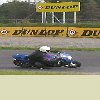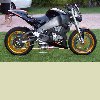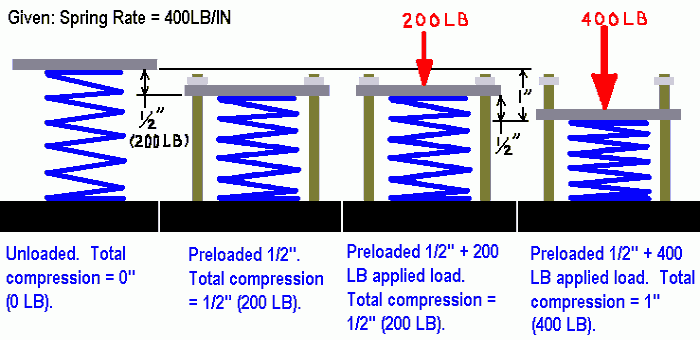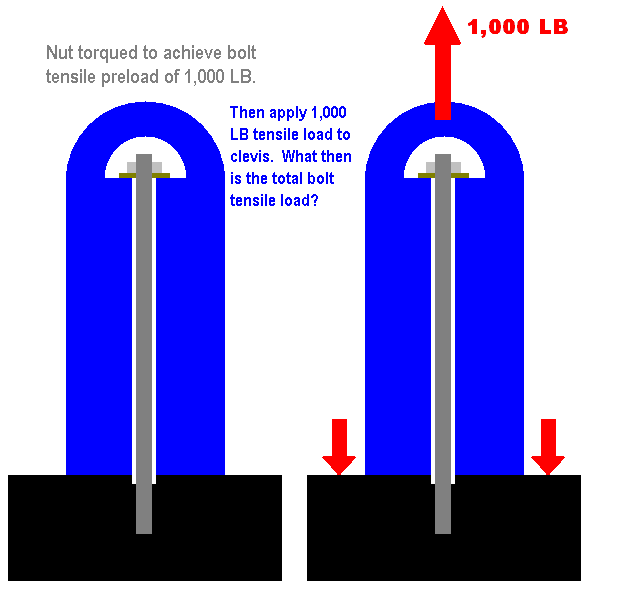| Author |
Message |
    
Surveyor

| | Posted on Sunday, February 06, 2005 - 12:39 pm: | 




|
charlieboy6649,
nope, you need to increase your compression damping. Increased preload wll delay the compression of the springs but won't add resistance to extreme compression. Increasing your compression damping increases the resitance to compression and delays bottoming out. I've had guys claim their forks were bottoming when it wasn't the case so check it out first by tying a cable tie on the fork slider close to where they enter the legs and when you get back from a test ride you'll be able to see how much of the fork travel you are using by measuring how much the cable ties have moved from their original position then you can check this against the spec. for the forks and establish if you are bottoming out......sounds complicated but it isn't. Hope this helps but mail me if I've just confused the issue.
(Message edited by surveyor on February 06, 2005) |
    
M1combat

| | Posted on Sunday, February 06, 2005 - 12:53 pm: | 




|
Yeah, increase your compression damping and maybe add a little rebound damping on the rear, but that's more of a bandaid. (/edit And will only help under braking, accel will remain the same)
Blake - I am pretty sure you are incorrect. You set sag/ride height with preload. You do NOT place static tension on the spring with preload. You would only be adding "preload" if the suspension was already at the top of it's travel, but even if it is and you have placed static tension on the spring, once you place a rider on the bike the spring will only sag to the exact same amount of compression (wrt the spring). The ride height will be higher, but the spring tension will remain the same given the same amount of travel. Adding preload WILL end up making the front higher when all of the weight is transfered forwards (unless you bottom the suspension), but it will travel just as far.
Chuck needs heavier weight springs. He's taller than 6'6" (if I had to guess) so his COG is a ways up there  . .
(Message edited by m1combat on February 06, 2005) |
    
Charlieboy6649

| | Posted on Sunday, February 06, 2005 - 03:15 pm: | 




|
Nah, I'm 6'4" 230 
I'm sure I could use stiffer springs, but I'm gonna stick with the stock bike. I'm not racing or anything... Just interested in if I do another BTX or a trackday what I can do to reduce the dive and rock back I'm getting... Sounds like what surveyor said was spot on thanks... Would heavier oil in addition to increased dampening also possibly help. I would think so?
P.S. thanks for the zip tie advice. I'll try it...
(Message edited by charlieboy6649 on February 06, 2005) |
    
Surveyor

| | Posted on Sunday, February 06, 2005 - 05:51 pm: | 




|
Charlieboy6649, youre absolutely right I forgot to mention heavier grade fork oil but then I didn't realise you are a giant!!! The guy whose race bike I prepare is a roughly similar size and we don't have bottoming out problems with his Kawasaki....problem is I can't remember what grade fork oil were running. I dont understand what you mean by 'rocking' but I generally use front and rear rebound damping to control chatter (skipping as you call it I think). One more point, make one (small) adjustment at a time and see how your bike responds rather than making lots of changes at the same time. |
    
Opto
| | Posted on Sunday, February 06, 2005 - 07:51 pm: | 




|
Surveyor
Front preload 5, comp 1.5, rebound 1.625
Rear preload 4, comp 2.25, rebound 1.25
Rider approx 140lb, pillion approx 100lb.
The rear comp setting makes big differences when turned 0.25 at a time.
The front I haven't spent much time on since it feels good. For solo riding I change the rear settings to preload 1, comp 3.5, rebound 2.0 and the front stays the same. |
    
Metalstorm

| | Posted on Sunday, February 06, 2005 - 08:02 pm: | 




|
Is it true that the R & the S require different settings? (i.e. the R needs a stiffer front setting than the S)) If this is true, is it simply because of the different seating position or is there more to it than that? |
    
Charlieboy6649

| | Posted on Sunday, February 06, 2005 - 08:43 pm: | 




|
By rocking back I mean when I get hard on the gas it also rocks back to the rear pretty good.
I'll ask my dealer what oils are available and per your advice try some small changes on a deserted road we've got out here...
Thanks for the advice.
(Message edited by charlieboy6649 on February 06, 2005) |
    
Wyckedflesh

| | Posted on Monday, February 07, 2005 - 12:33 am: | 




|
Some Lightning owners have also commented on the use of the aggressive settings and how much better they prefer them. Just remember, those settings are a base for you to adjust from in order to fit YOUR riding style and comfort. |
    
Opto
| | Posted on Monday, February 07, 2005 - 10:03 am: | 




|
Wycked, have you fitted that race ecm yet? I'm looking forward to hearing the results...  |
    
Wyckedflesh

| | Posted on Monday, February 07, 2005 - 10:08 am: | 




|
Not yet, working on it though as fast as I can. The biggest setback at the moment is getting the TPS reset (shop is backlogged 2-3 weeks and are only taking emergency walk ins.) and finishing up all the prehire stuff for my new job. |
    
Glitch

| | Posted on Monday, February 07, 2005 - 10:29 am: | 




|
Some Lightning owners have also commented on the use of the aggressive settings and how much better they prefer them.
I'm one of those guys.
I use the settings from the R owner's manual.
I feel much more planted.
I'm gonna see if this will be good enough for when I install the Cross Roads this afternoon.
I may end up using the aggressive settings.
We'll see. |
    
Rigga

| | Posted on Monday, February 07, 2005 - 10:40 am: | 




|
got some lsl bars to fit when i can be bothered to go out and get some new grips and bar ends.... but from holding the bars up to the clamps the bend does not look so far off the standard,maybe a little more upright and slightly set further back,not so much of a difference that it might throw off the suspension settings have now i would have thought,time will tell though |
    
Trenchtractor

| | Posted on Tuesday, February 08, 2005 - 05:08 am: | 




|
'You set sag/ride height with preload.'
No way, use your preload to set the sag only...
Set your ride height by changing your geometry.
Change spring rate with different springs.
Change your damping rates using your damping adjusters.
It's not hard, just remember what each component is DESIGNED to do and use it to adjust ONLY what it is designed to adjust.
So on the XB's you can adjust the front ride height using the triple clamp, but you can't change the ride height of the rear. You can affect the ride height of the rear, though...  But that's a side effect of preload. But that's a side effect of preload.
'Is it true that the R & the S require different settings?'
Yes. Different seating position means different weight bias... My bike new came with an R manual, I had to use it until the S manual came in... The settings in the book are different.
Here's and idea... If you like the way your bike handles and you are changing the rider position through different bars, why not measure your sag now with the stock bars, then set your sag with the new bars to be the same... This will then dictate your preload adjustment for the new bars... |
    
M1combat

| | Posted on Tuesday, February 08, 2005 - 10:59 am: | 




|
"'You set sag/ride height with preload.' "
"You can affect the ride height of the rear, though... But that's a side effect of preload. "
That's what I said... |
    
Wyckedflesh

| | Posted on Tuesday, February 08, 2005 - 12:35 pm: | 




|
Your affecting the ride height of the rear with preload, but you aren't setting the ride height with the preload. There is a BIG difference between the two. Too much preload will cut down on the amount of suspension play you have, yet if you adjusted ride height properly, you wouldn't be affecting the suspension play which would allow you to properly set the preload. |
    
M1combat

| | Posted on Tuesday, February 08, 2005 - 01:21 pm: | 




|
Understood  . But you still set ride height with preload. It's not my fault it's just a side effect . But you still set ride height with preload. It's not my fault it's just a side effect  . In any case, You DON'T set static spring tension with preload. . In any case, You DON'T set static spring tension with preload. |
    
Ingemar
| | Posted on Tuesday, February 08, 2005 - 03:10 pm: | 




|
Whaa! Agreement within 4 posts on a suspension topic. You're spoiling my fun. Can we note this in the Badweb Book of Records?
 |
    
Trenchtractor

| | Posted on Wednesday, February 09, 2005 - 06:25 am: | 




|
I'd like to be pedantic here...
In a perfect situation you would have a shock that was adjustable for height, preload, comp and rebound damping...
In a situation where the ride height was correct and you wanted more preload you would adjust the preload up, then adjust the ride height BACK to where it was before...
Thereby ensuring the ride height remains correct while the preload is adjusted.
Since we don't have a height adjustable rear shock standard, the adjustment of the preload causing ride height changes is purely a side effect... Unfortunately there are people who see statements like yours, M1, and missinterpret them, then people are attempting to adjust ride height using preload and wondering why their bike turns in great but wallows or pogo's about all through the turn...
I recommend not using the preload to affect height adjustment, or you will move away from the correct sag set-up...
It is better in our case to affect geometry changes using the height of the forks in the triple clamp... Remember here that you want to change the geometry WRT the surface you are on, up at the back, down at the front... The downside to lowering the front is reduced ground clearance, but who here has ground clearance issues?? |
    
Opto
| | Posted on Wednesday, February 09, 2005 - 10:08 am: | 




|
I do when I'm surfing down a rock infested ravine/ bush driveway 2-up with full gear and the Drummer becomes the crush zone between bike and rock...I don't go down that driveway anymore...girlfriend yelled out oh •••• and I yelled out what and then we were committed  |
    
Surveyor

| | Posted on Wednesday, February 09, 2005 - 04:42 pm: | 




|
Trenchtractor, in my opinion you are absolutely correct, ride height is altered incidental to altering pre load and may or may not necessitate readjustment of actual ride height. However I have found that unless you are making a significant adjustement to your rear preload you don't end up having to adjust your ride height. On the other hand adjusting the actual ride height (eg. on Ohlins shox)makes a significant change to the handling. I have never had to adjust the front end ride height as a result of changing the front end preload. In theory if you up the front end preload you should slow the steering down but the reality - in my experience - is that any change to the ride height is negligible. |
    
Wyckedflesh

| | Posted on Wednesday, February 09, 2005 - 06:34 pm: | 




|
Opto FYI since you popped it up here, Race ECM was fitted today along with exhaust. It runs good, but haven't been in "ping" situations. It was very smooth sailing all day. |
    
Blake
| | Posted on Thursday, February 10, 2005 - 01:10 am: | 




|
"So Blake, please, with your track experience help me. If my front end is diving, preload is what I need?
Being a novice I'm reluctant to go fiddling with my factory settings..."
Charlie,
Set your suspension sag, front and rear, to be within specifications. As large as you are, it would be WELL worth your money to invest in a set of proper (stiffer) springs for your suspension. I'm by no means an expert at adjusting suspensions for the track, but with the advice you've received I agree. More compression damping and even more rebound damping on the rear will slow your diving, and the converse for keeping the rear end from squating too much under acceleration. Your owner's manual should provide a pretty good guide to suspension setup. Check it out. Most importantly, record everything and make only one change at a time. Most, most importantly, setup your suspension according to specifications. If you don't know your starting point, you will have all kinds of trouble making improvements.
Record all settings, static sag, rider and total sag, compression and rebound damping settings. Make one change at a time, record your observations, take your time.
M1,
"Blake - I am pretty sure you are incorrect."
I am 100% absolutely certain I am correct.  I think that beats your "pretty sure." I think that beats your "pretty sure." 
What I said...
quote:"Preload" is the 100% exactly perfect name. For when you adjust shock/fork preload, you are altering how much the spring is loaded (compressed) prior to it ever being loaded further through action of the suspension/shock mechanism; the spring is thus already loaded, or pre-loaded with an initial compression "preload." Until the compression load acting on the shock through the suspension exceeds the spring preload, the shock will not compress.
The above is absolutely 100% accurate. It is not at all intuitive. A picture is in order. 

Spring Preload Illustration 
(Note, the above does not properly illustrate the relationship of preload in a shock or fork; it merely illustrates simple spring preload behavior. A shock is setup so that the preload adjustment is always engaged, as if from the bottom/black base shown above instead of the top/gray plate. The gray plate would represent the suspension input end (swingarm or axle end of the shock/fork assemblies as applicable).
"You set sag/ride-height with preload."
I agree with clarification that though sag affects ride height, preload is not the means one uses to affect ride height independent of sag. What the tractor man said.  In general we don't worry about ride height on our street motorcycles anyway. That is for the racers to consider in making changes to the geometry of their bike. In general we don't worry about ride height on our street motorcycles anyway. That is for the racers to consider in making changes to the geometry of their bike.
"You do NOT place static tension on the spring with preload."
I think you meant to say "compression" instead of "tension." But you are indeed loading the spring in compression by increasing preload. By increasing preload you are exerting additional compression on the spring.
"You would only be adding "preload" if the suspension was already at the top of it's travel,
No, while preload is referenced wrt the spring's/shock's/forks' unloaded state (at the top of the shock/forks travel) one can certainly add preload even if the shock is compressed. Heck you can dial up the preload even if the shock is fully compressed. As you do so, you act to further compress the spring, and thus if the shock were just at the point where it was fully compressed, the additional preload would tend to cause the shock to extend away from full compression.
...but even if it is and you have placed static tension compression on the spring, once you place a rider on the bike the spring will only sag to the exact same amount of compression (wrt the spring).
That is correct. No matter the preload (as long as preload does not exceed total shock loading under bike+rider weight), the spring will compress the same total amount. That is to say that a shock spring that has a spring rate of 400 LB/IN will deflect from its unloaded state exactly 1.0 inch for every 400 LBs of load applied to it. If you dial in 1/2 inch of preload to the shock/spring and then load it with 400 LBs, the spring will compress a further 1/2 inch for a total of 1.0 inch spring compression, but your shock has only compressed 1/2". The first 1/2" of spring compression was "preload."
This can be tough to follow. Consider that the shock won't move at all until the load applied to the shock exceeds the spring preload (200 LB in our example case), since that is the load induced into the spring by compressing it the 1/2" via the preload mechanism. That 1/2" of spring pre-loading exists within the compressed spring even if the shock is removed from the bike. That is the shock/spring preload, how much the shock's spring is already loaded prior to any applied compression loading to the shock assembly. The spring is thus pre-loaded 1/2" corresponding to 200 LBs. The shock will not begin to compress until that 200 LB spring preload is offset by an equal 200 LB applied load.
"The ride height will be higher sag will be reduced, but the spring tension compression will remain the same given the same amount of travel.
Yes, the spring will see the same total amount of compression wrt its unloaded state. But with added preload, the amount of shock/suspension travel will be reduced for equivalent loading. I promise.
Adding preload WILL end up making the front higher when all of the weight is transfered forwards (unless you bottom the suspension), but it will travel just as far."
Wrong. The spring will be compressed the same amount, but the shock/forks will not compress as far. Why? Because more of the load being applied to the shock/forks is required to overcome the preload and is thus not available to act to further compress the spring.
Consider the extreme... If you set the preload such that it equals the total applied shock static load of rider+bike, the shock will not compress at all.
Or the other extreme, a very weak spring... If you had a shock with a low spring rate of say 100 LB/IN and you need the shock to support 400 LB of static loading for a shock sag of only 1/2", how much preload would you need to dial in?
Answer 3.5"
Preload at 3.5" spring compression would be 3.5IN*100LB/IN=350LB. That leaves 50 LBs of the 400 LB applied static loading left to further compress the spring and to begin compressing the shock. That additional 50 LBs in excess of the preload will cause the spring to compress an additional 50LB/(100LB/IN)=0.5IN 
Trust me, this is not intuitive. I struggled with it myself in machine design class in college. Since then it has become integral to my cherished profession. 
(Message edited by blake on February 10, 2005) |
    
Glitch

| | Posted on Thursday, February 10, 2005 - 09:37 am: | 




|
Thanks Blake. |
    
M1combat

| | Posted on Thursday, February 10, 2005 - 01:51 pm: | 




|
Your example above is flawed. You are applying preload incorrectly when compared to a front fork (or rear for that matter). Your preload mechanism is connected to the base that the spring is sitting on. That's not the case with suspension.
You only apply preload in the fashion that your example exhibits if your suspension is already at the end of it's travel (at the top specifically). If it isn't, then the preload adjustment just extends the suspension. The load on the spring only changes because you have VERY SLIGHTLY changed the weight balance of the vehicle.
""Preload" is the 100% exactly perfect name. For when you adjust shock/fork preload, you are altering how much the spring is loaded (compressed) prior to it ever being loaded further through action of the suspension/shock mechanism; the spring is thus already loaded, or pre-loaded with an initial compression "preload.""
This is ONLY true when the suspension is already extended to maximum length (this is not the case while we are riding). If the suspension is compressed at all (with any kind of sag) then the preload adjust ONLY changes the length of the suspension component. I stated that before. My point with it was that we don't ride or adjust the suspension with it topped out. Therefor, how the preload works in that situation is irrelevant. What is relevant is how it works while we are riding the motorcycle. IMO, it should be named wrt how it works when we are riding, not when the bike is in the air, or when the suspension is not installed.
Don't get me wrong, I understand what you are telling me, it's just that we don't ride around (or even let our bikes sit) with the suspension topped out, so preload ONLY affects the height of the motorcycle (along with the trail and swingarm angle (which I believe should stay as close to perpendicular to the rake as possible durring cornering loads to limit the change in wheelbase)). It will not affect how far the suspension travels, it only affects where the suspension travels wrt the top and bottom of it's stroke.
Say you have a 100lb/in spring and your bike sits at 1mm of sag... How much weight will it take to compress the suspension 1"?
Say you have a 100lb/in spring and your bike sits at 30mm of sag... How much weight will it take to compress the suspension 1"?
Say you have a 100lb/in spring and your bike sits at 0mm of sag... How much weight will it take to compress the suspension 1"? You're right... Who knows. And what's more, it doesn't matter because we should never be there except in the case of a wheelie/stoppie.
You are correct that preload is preload, but only when the bike is in the air. All other situations, it acts as a way to tune where your suspension travel will be related to the top and bottom of the travel. It adjusts ride height. |
    
M1combat

| | Posted on Thursday, February 10, 2005 - 02:07 pm: | 




|
If, however, you are Court and you can fly... Then a preload adjuster does indeed adjust preload. But while Court is flying around he can adjust preload all he wants to and it won't affect the bike at all, because he is only adjusting kinetic energy.

Ask Marcus McBain about it. He's a professional in this specific subject. |
    
Surveyor

| | Posted on Thursday, February 10, 2005 - 03:10 pm: | 




|
M1, I think this discussion is becoming so theoretical that it is straying into the "how many angels can balance on the head of a pin" zone. My approach is much less learned or scientific than either your's or Blake's. However I tend to disagree that Preload adjustments of the scale normally carried out in setting up a bike will significantly alter ride height - based on practical experience only. Sag height is a function of the response of both front and rear suspension to a dead or live load, adjusting preload on the rear suspension alters sag height but the alteration is diluted by the fact that the front suspension also reacts to the changes made to the rear. Preload alters the point at which the suspension reacts to a stimulus (a bump) damping alters its response to the stimulus. All of these adjustments can alter the geometry of the bike (to a limited extent) but that is not the intention and for the most part nor is it significant. Race shocks have specific provision to alter ride height for the very reason that significant adjustment cannot be achieved any other way. |
    
M1combat

| | Posted on Thursday, February 10, 2005 - 04:49 pm: | 




|
I agree... Pre-load is not the "correct" way to alter ride height. However, It does alter ride height by almost the exact same ammount that the preload adjuster is adjusted. If you adjust the preload in 1mm (more "preload" , then when you are healed over in a turn, the front ride height will me almost exactly 1mm higher. I think just a tad more than 1mm because you are transfering less weight to the front as well as starting out 1mm higher. Of course, this is in a perfect world with no stiction , then when you are healed over in a turn, the front ride height will me almost exactly 1mm higher. I think just a tad more than 1mm because you are transfering less weight to the front as well as starting out 1mm higher. Of course, this is in a perfect world with no stiction  . Dampers have a range where they work best. In a perfect world, you would adjust the sag so that you ride within this sweet spot. You would adjust the ride height via raising/lowering the forks in the trees, or adjusting the rear adjuster for ride height. This assumes that you are ALREADY in the sweet spot of the travel range of the damper. If you are not, you would adjust the preload to get there (once you install springs of the correct load rating). Preload will make finite adjustments to the weight balance of the bike. That is because the preload (in a riding condition, not while flying) ONLY adjusts the ride height (and all other side effects that come along with adjusting the ride height) of the bike. . Dampers have a range where they work best. In a perfect world, you would adjust the sag so that you ride within this sweet spot. You would adjust the ride height via raising/lowering the forks in the trees, or adjusting the rear adjuster for ride height. This assumes that you are ALREADY in the sweet spot of the travel range of the damper. If you are not, you would adjust the preload to get there (once you install springs of the correct load rating). Preload will make finite adjustments to the weight balance of the bike. That is because the preload (in a riding condition, not while flying) ONLY adjusts the ride height (and all other side effects that come along with adjusting the ride height) of the bike.
Adjusting the ride height via fork placement in the triple tree, or via the preload has mostly the same effect when riding with these exceptions...
You can adjust the preload to where your damper is not working in it's sweet spot (you can bottom or top the suspension).
You can extend the overall length of travel with the preload adjuster (although in doing so you may move to where you are no longer in the sweet spot of your damper). I don't mean from bottom to top, but if you are bottoming, you can adjust the preload to that you aren't bottoming anymore. You start out higher, and alomost bottom, so you have increased the range of travel that you are using...
You can leave the fork unit's characteristics alone if it is perfect and adjust the position where it is at in the triple tree instead to gain/lose ride height.
BOTH methods affect trail and rake.
for the record... I'm pretty sure my approach is much less learned and/or theoretical than Blakes. I can't fly in order to use the preload adjuster as a preload adjuster, and I only took Physics in highschool. I even failed the class, but I learned a lot and always listened. I just didn't do the homework. I did well on tests though, and then read through my father's "Applied Physics" book many times.
In any case... In certain situations (forks topped out) the preload adjuster adjusts preload. In other situations (fork not topped out) the preload adjuster adjusts ride height and the area of travel that you are using. BOTH affect rake and trail.
An example... There'a a huge bump going into Turn 88. You're healed over pretty good and on the brakes and your forks bottom over that bump. Other than exactly right there, your suspension is flawless. Add preload and raise the forks through the trees. Don't adjust too far, because you don't want to top out.
In any case... I'm willing to open my mouth and insert my foot, but no one so far has convinced me that I need to do so.
Also... I don't have time at the moment to correct spelling errors. My apologies  . . |
    
Blake
| | Posted on Thursday, February 10, 2005 - 07:55 pm: | 




|
I'm a poor teacher. 
Please read the notes underneath my illustration above.
If I have time, I'll revise it to accurately illustrate actual shock/fork behavior. I should have done so initially, but I didn't think of it. 
The answer to your questions as to how much weight (I assume you mean additional applied loading) is required to further compress the suspension 1" is... 100 LB for each case you mentioned except for the zero sag one which is impossible to know unless more information is provided, namely the preload and static sag loading.
Lets try the math. 
The equation governing the behavior of a linear spring is very simple as follows:
F=KX
or
X=F/K
Where:
F is the applied load acting upon spring
K is the spring rate
X is the spring displacement
Now let us add to the equation preload (P0) calculated as being equal to an enforced displacement (X0) times K or...
P0=KX0
We have then two cases for a preloaded spring:
One where the applied load is greater than or equal to the preload, (F³P0), and one where the applied load is less than or equal to the preload, (F£P0).
Now instead of having initially an unloaded spring, we enforce through constraint an initial spring displacement (X0). The spring is constrained via a preloading mechanism. We then apply load (F), just like for a motorcycle suspension (shock or fork).
We are interested in spring displacement (X) versus applied load (F) from its initial preloaded condition (X=X0). We are not concerned with total spring displacement (X0+X), we are concerned with total shock displacement thus only the spring displacement from its initial constrained/preloaded condition.
For our case of interest (shocks and forks) the displacement is always acting to compress the spring.
For the case where F£P0) the shock compression displacement is zero. The applied load cannot overcome the shock's spring preload, thus the spring will not compress further. Agreed?
For the case where F³P0) the shock's static (no dynamic/damping effects) displacement under applied loading will be exactly...
X=K(F-P0)
Agreed? What the above shows is that for any shock compression to occur, the applied load (bike+rider) must exert more force than that exerted by the spring in its preloaded (pre-compressed) condition.
Adjusting the preload of a shock or fork does not affect the stroke of the suspension component. Agreed?
Increasing the preload by xy LBs also increases the load required to bottom the suspension by exactly the same xy LBs. Agreed?
More later...  |
    
Blake
| | Posted on Thursday, February 10, 2005 - 08:07 pm: | 




|
Preload adjustments do not affect preload??? 
Sorry, you lost me on that one. Please see above governing equation.
Remove shock from bike. Adjust preload to minimum. Measure how much force is required to initiate shock compression displacement.
Adjust preload to maximum, repeat.
You have just determined your shocks preload min/max capabilities in LBs. That remains the same whether the shock is on the bike or off. It is preload, and as stated, it is perfectly 100% accurately described as such.
BTW I think my BSME probably trumps your failed physics class experience. Trust me, I'm not lying to you on this.  Remove all applied load from the shock or forks and what you have left is the preload. The shock or forks will not compress until they are subjected to a load exceeding that preload. Remove all applied load from the shock or forks and what you have left is the preload. The shock or forks will not compress until they are subjected to a load exceeding that preload.
Preload does not stiffen your suspension. Preload only adjusts the ratio of compression to rebound travel, more conventionally addressed via the sag setting. |
    
Blake
| | Posted on Thursday, February 10, 2005 - 09:08 pm: | 




|
I think where you may be confused is in thinking that unless the shock is fully extended there is no preload. That is not true. The only time there is no preload is if in the shocks fully extended condition the spring is not compressed. Which should never ever be the case.
Are you familiar with bolt preload? It is the same thing. When you torque up a bolt, especially a bolt with a long grip length, you are preloading it in tension.
Here's the one that befuddled me in college...

Given the bolt/stud joining the blue clevis to the black base via threaded connection into base and nut on clevis. Given the nut is torqued to achieve a bolt/stud tension of 1,000 LBs with no load applied to the clevis. Given all materials are steel. What will be the approximate tension load in the bolt/stud when the clevis is acted upon by a 1,000 LB load as shown? |
    
Blake
| | Posted on Thursday, February 10, 2005 - 09:15 pm: | 




|
Question #2: If the effective spring rate of the bolt/stud is 1,000 LB/mm, how much will it elongate from its unloaded to loaded configurations shown above. |
    
M1combat

| | Posted on Friday, February 11, 2005 - 12:10 am: | 




|
1000#.
I'm beginning to see where we are mis-communicating...
The thread was about the way motorcycles handle, and the ways to change how they handle. A Preload adjuster doesn't change the feel of the spring at all. The felt differences to the rider will only be ride height adjustments (and the accompanying side effects). That is unless, of course, if you adjust it so far that you are using parts of your suspension travel that are too near the ends (or ARE the ends) or are otherwise not it's sweet spot.
I understand your example above and I understand what you are saying (even when you were speaking Algebra), I just feel that preload is a bad name for our application because what it really changes for us is the rideh eight. I also understand that the other method of ride height adjustment has it's own benefits and drawbacks.
I'm still trying to figure out how F1 teams can tune an EIGHT spring setup on each end of the car... With variable down force... Sheesh  . I'm kind of assuming that they get their baselines from the computer they use in the design of those systems. . I'm kind of assuming that they get their baselines from the computer they use in the design of those systems. |
    
M1combat

| | Posted on Friday, February 11, 2005 - 12:20 am: | 




|
"Increasing the preload by xy LBs also increases the load required to bottom the suspension by exactly the same xy LBs. Agreed? "
No. We put F on the spring with either M or P0. Either way we need the same X0 to get to that point so the total F at maximum X0 will be equal either way. This is why I feel "preload" is a bad name in our application because the user doesn't feel the difference in P0. The feel the difference in ride height when the "Preload" is adjusted. |
    
M1combat

| | Posted on Friday, February 11, 2005 - 12:25 am: | 




|
"Question #2: If the effective spring rate of the bolt/stud is 1,000 LB/mm, how much will it elongate from its unloaded to loaded configurations shown above."
I'm not sure... but I think 1mm... |
    
12bolt

| | Posted on Saturday, February 12, 2005 - 05:23 am: | 




|
This thread started out really useful for us less educated hillbilly type, now I don't have a clue how this is going to help us set up our suspensions.
For the first time (don't ask me why, I've just been enjoying the ride so far) I checked the manual settings against what came on my bike from the dealer. Yikes! Not even close! The dealer had the front set up for like a 300lb person and the back for a 140lb rider. I adjusted the setting according to the book and what do you know, it rides much better!
all said I would still like to fine tune it a little more. Any thoughts would be appreciated.
12bolt |
    
12bolt

| | Posted on Saturday, February 12, 2005 - 06:21 am: | 




|
I take that back. This started off as a TFI Thread! Like I said uneducated Hillbilly!
 |
    
M1combat

| | Posted on Saturday, February 12, 2005 - 03:33 pm: | 




|
Thread spread rules  . .
That's why you just have to read everything here... |
    
Surveyor

| | Posted on Saturday, February 12, 2005 - 03:59 pm: | 




|
12bolt, I started this thread as an alternative to the myriad TFI threads on this forum and in the hope of exciting some interest in the setting up of bikes as opposed to the relentless pursuit of more BHP. I'm afraid I agree with you that the thread has become over scientific/theoretical in it's content - thought the science is important. Perhaps this is a good time to end this thread and for you to start a new one with your post about the setup you have discovered on your bike, I'm convinced your case is not unique and there are many forum members who are fiddling with their TFI settings while there bike is wrongly set up. Obviously us Irish and you Hillbillys have something in common. |
    
Trenchtractor

| | Posted on Saturday, February 12, 2005 - 06:17 pm: | 




|
Surveyor,
'In theory if you up the front end preload you should slow the steering down but the reality - in my experience - is that any change to the ride height is negligible.'
I only posted that explanation since only days before you started this thread I was discussing with someone else... Long story short, he was trying to speed up handling by reducing preload to steapen up the front end... Then he was complaining that the front was soft... Basically, I think that he was trying to effect geometry changes using the incorrect setting...
Opto,
'I do when I'm surfing down a rock infested ravine/ bush driveway 2-up with full gear...'
I know you know I was talking about lean angle ground clearance...  |
|